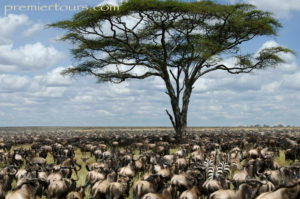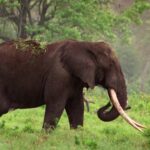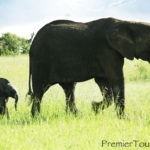When to Travel to East Africa to Behold the Wildlife Great Migration
Beholding the wildlife Great Migration is renowned as one of most visually stunning adventures you could ever add to your travel bucket list. Specifically, the Great Migration of hundreds of thousands of wildebeest, antelope, gazelle, and zebra begins in Tanzania’s Serengeti and steadily follows a path to the southwestern border of Kenya.
Determining when to travel to East Africa to view the Great Migration hinges on a number of factors since different times of the year are marked by pronounced variations in scenery and game. Ultimately, it all depends on what you’re hoping to gain from this once in a lifetime experience.
Here is a chronological overview of the path of the migration to help you pinpoint when to travel:
- January – February- New year, new wildlife! Wildebeest are inclined to congregate in the southern portion of the Serengeti in February where they give birth to thousands of baby calves. The Ngorongoro Crater region is ideal for the 2-3 week span of calving season since the soil and grass here is rich in potassium, calcium, and phosphorus from volcanic eruptions two million years ago.
- March – The end of February and the entire month of March is known to have extensive levels of predatory activity in the Ngorongoro region. The newly born calves are easy targets for carnivorous animals like lions, thereby signaling an internal alarm clock within the wildebeest species that it’s time for a change of scenery.
- April – May- While there are myriad sights to behold during these months, it would likely behoove you to wait until June and July to fully immerse yourself in this natural wonderland. April is when the Serengeti begins to noticeably dry up and when most of the grass disappears. Hence, the herds head west along the path of the Grumeti River.
- June – July- This is arguably the BEST time of the year to really see the good stuff! June and July is when the herds pick up the pace towards the Masai Mara since this reserve gets rain from the nearby Lake Victoria. This is also the time of year when the herds face the challenging obstacle of crossing over the Grumeti River. Wildebeest and zebra drink several gallons every day from this water source. Travelers will be able to view all the excitement playing out around the Grumeti and beyond, so consider planning a game drive along the river to view the action at close proximity.
- August – September – August is likely the best month to catch a river crossing. By August, the wildlife has trekked to the Masai Mara region where it’s time to cross over the Mara River. If you’re keen on witnessing the crossings, take note that patience is required for this waiting game. Consider taking a hot air balloon over the Masai Mara for a bird’s eye view of the crossing.
- October – The first portion of October is a picturesque time of year in the pool-table flat Masai Mara grasslands. In the beginning of the month, the wildlife is still grazing. Late October is when the herds begin trekking back down to the northern Serengeti where short grass is abundant.
- November – December – At long last, the wildlife reaches the Seronera area where they will stay until going back to the Ngorongoro region for calving season once again.











